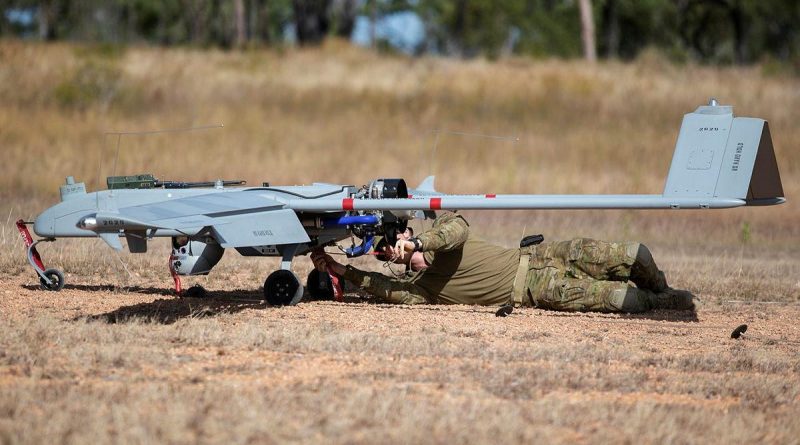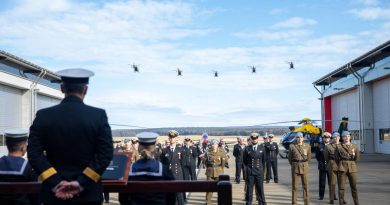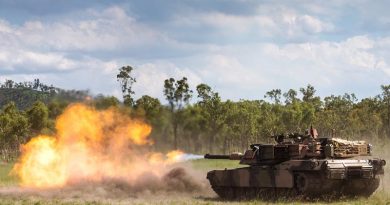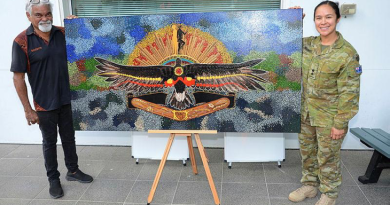Attack directed from the Shadows

M777A2 Howitzers were brought into action ready to fire. Tiger helicopters established battle positions ready to engage targets.
CAPTION: Lieutenant Dallin Stirling attaches post-flight safety tags to a Shadow 200 during Exercise Dragon Sprint at the Townsville Field Training Area. Story and photo by Petty Office Lee-Anne Cooper.
But the Shadow 200 unmanned aerial vehicles (UAV) and their targeting lasers were the stars of the show on exercise Dragon Sprint.
The exercise was held at the Townsville Field Training Area from June 21-23, and the UAVs were flown by gunners of the 131st Battery, 20th Regiment, Royal Australian Artillery.
The Shadows designated targets for artillery and close-air support from about 9000 feet above the battlefield.
Laser-designated coordinates fed to the gun line enabled fire missions to be undertaken at maximum range, while Tigers launched Hellfire missiles that the Shadows guided onto their targets using laser.
Huddled around a screen in a viewing tent, eager drone operators watched three dots forming a triangular sight held over a target.
There was silence and a collective breath was drawn as the personnel waited for the Hellfire to strike in the battery’s first laser-guided live-fire task since 2017.
20th Regiment Adjutant Captain Christopher Moroney said using Shadows for target acquisition meant less risk to other assets.
“Shadow can designate a vehicle-size target with as much accuracy as a Tiger. This reduces the risk to the Tiger – or another manned platform – doing it for itself,” he said.
“This, however, does not replace the ground-based observer, as we are a weather-dependant system.”
A forward observer still had to see the target before firing, but using the Shadow meant they didn’t need to get so close to the target, according to gun detachment commander Bombardier Bryson Smith, from the 106th Battery, 4th Regiment, Royal Australian Artillery.
“The target location depends on how close they need to be to that target,” Bombardier Smith said.
“They have to have a good line of sight to call in effective fire, so with UAVs, they do not need to be as close to the target and you can get a better acquisition and we can fire more effective rounds.”
With a range of 125km, the Shadow can fly well past the artillery’s maximum range.
This was further extended during the exercise by dislocating the Shadow operators 50km from the airfield, creating a battery forward position.
Laser designation principles mean the closer the Shadow is to the target, the more accurate it will be, and during the exercise, 12 successful Hellfire designations were achieved.
“Apart from range and target information, we can provide video, stills and have the ability to observe day and night using infrared,” Captain Moroney said.
“Being an aerial observer, it gives us a better perspective of the battlefield and you always want height and good optics to engage the target. This allows adjustments to be made more efficiently.”
Captain Moroney said the development of the capability was driven by the progression of training.
“First, we work in the simulator, and then practise it and execute it for real,” he said.
“It ultimately proves the system works and the soldiers are ready.”
The training value of Exercise Dragon Sprint was also extended to the School of Army Aviation, which brought in their aircraft and crews.
The school’s Commanding Officer, Lieutenant Colonel Scott Doré, said the school brought their entire Tiger training staff along with three trainee pilots to the exercise, and it was the first time they had worked with the 20th Regiment.
“It is a unique opportunity for us to develop our staff and for our trainees to see and be exposed to training they would not normally have the opportunity to at this point,” he said.
“We train our gunnery on a simulator and you do not get all the learning associated with expending live rounds and going through the range safety planning involved with a live-fire activity.”
The forward arming and refuelling point was also abuzz with activity, with significant ground assets required to support the aircraft.
Staff from the School of Army Aviation will look at the feasibility of supporting similar exercises in the future with benefits also identified for ground crew.
“Our aircraft support staff are not just refuelling, they are practising the core skills of loading ordnance onto an aircraft from a deployed location in the field, which is what our tradesmen joined the Army to do,” Lieutenant Colonel Doré said.
Exercise Dragon Sprint was the final in a series leading up to Exercise Talisman Sabre, which begins this month.
.
.

.
.





